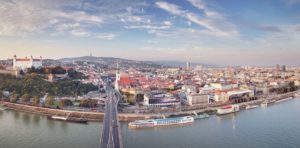Special to WorldTribune.com
BRATISLAVA, Slovakia — The majestic Danube River connects Vienna, Bratislava and Budapest.
Just 40 miles downriver from Vienna, the historic city of Bratislava rises above the Danubian plain. Still the turrets of Bratislava castle on the hill are more picturesque than forbidding but are usually missed in a journey between Vienna and Budapest. Yet here awaits a positive story, largely overlooked by the major media but very well known to foreign investors.
First a bit of history. Once part of the Austro/Hungarian Empire, after the First World War, what is today’s Slovakia formed part of old Czechoslovakia founded in 1918. Following the Second World War, Czechoslovakia fell under communist control and was part of the East Bloc.

Despite its relative proximity to Vienna, during the Cold War, Bratislava was largely forgotten and forsaken until 1989 when this epic year of freedom, brought Eastern Europe and with it Czechoslovakia, out of the cold.
In what was called the velvet divorce, Slovakia peacefully separated in 1993 from Czechoslovakia in a move many pundits thought imprudent, but were proven wrong. Bratislava is the capital of this country of five and a half million people (5.5 million).
Though certainly in the shadow of opulent Vienna or even Budapest, historically Bratislava, once known by its Hungarian name Pozsnoy, was a city of eleven royal coronations. During the Ottoman/Turkish occupation of Hungary, this city served as the seat of Royal Hungary. In June 1741, Maria Theresa, one of Austria’s most powerful monarchs, was crowned at St. Martin’s Cathedral.
Nonetheless Bratislava, this gem of a once thriving royal city, is not yet a tourism nexus.
From the dark days of the Cold War and socialist economy, since 1989 through hard work and focused policy, Slovakia has emerged as a multi-party democracy and an economic success story.
Freedom House, the human rights watchdog group adds, “Slovakia has been among the most obvious economic success stories in post-communist Europe, and with economic growth topping 3 percent in 2015, it is one of the fastest growing economies in the European Union (EU). ”
According to the media monitor Reporters Without Borders, Slovakia ranks number 12 globally in press freedom out of 180 countries; just behind Austria but ahead of Canada and the USA.
The Washington based Heritage Foundation think tank adds, “A prudent regulatory framework for the financial sector combined with competitive tax rates has fueled Slovakia’s transition into a flexible and vibrant market-based economy with considerable resilience. Openness to foreign trade and investment has positioned the country as one of the most attractive destinations for foreign direct investment in Europe.”
For a number of years already, the country has become home to high profile manufacturing industries. Korean firms such as Samsung produce widescreen TV for the European market.
Though Slovakia was traditionally known for its heavy industries during the socialist era, the country has in a sense reinvented itself with far reaching market reforms to attract investors.
Surprisingly Slovakia is one of the world’s largest auto producers with Germany’s Volkswagen, the French PSA Peugeot Citroën and South Korea’s Kia Motors as major manufacturers. Over a quarter million people are employed in the automotive industry. Labor costs are far below those of Germany and France.
American firms such as Dell, HP, IBM and Microsoft are well established in the computer and IT sector. Research & Development and computer security centers thrive and form a vital element in Slovakia’s rich high-tech landscape.
Two way trade between Slovakia and the USA reached $2.7 billion in 2015.
Last year Slovakia attracted $479 million in foreign investment mostly from Europe and East Asia. Foreign Direct Investment into Slovakia increased to $2,6 billion in the first half of 2016.
Given that Slovakia is a member of the European Union since 2004, as well as in the Euro currency zone, the country is well poised for intra-European trade. Equally, geography and transport routes favor Slovakia which is located as a transit hub between West and East. However, there’s a dangerous dependence on Russian energy supplies.
On the international front Slovakia is a member of both the European Union and NATO, a vital insurance policy for the country. Though currently holding the rotating Presidency of the European Union, Slovakia’s tenure has been overshadowed by the British BREXIT crisis. Slovakia has provided troops to the NATO mission in Afghanistan as well as to UN peacekeeping missions. Slovak Foreign Minister Miroslav Lajcek is currently a candidate for the post of UN Secretary General.
While the mighty Danube binds Slovakia into central Europe, the high Tatra mountains exemplify the spirit of this small country to excel and reach for the heights.
John J. Metzler is a United Nations correspondent covering diplomatic and defense issues. He is the author of Divided Dynamism the Diplomacy of Separated Nations: Germany, Korea, China (2014). [See pre-2011 Archives]

